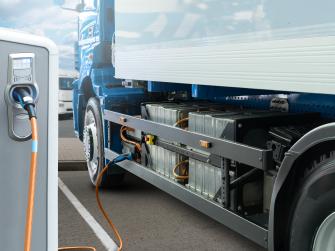Innovation Will Take Electric Trucks Further, Faster
Electric trucks have come a long way in just a few short years. It's been only five years since Cummins and Tesla first unveiled prototype electric freight trucks and three years since the first trucks hit the road in the Volvo LIGHT Project. Since then, hundreds of fleets have added their first electric trucks, and annual sales have grown into the thousands.
While electric trucks have proven they are already capable of performing many of the needs fleets have today, they have also demonstrated they continue to get ever better. This innovation expands the horizon for how far electric trucks can take us down the road to a zero-emission future.

Batteries are the heart of electric vehicles, and continued innovation in battery technology will accelerate the adoption of electric trucks by driving down upfront costs, cutting down charging times, expanding driving range and reducing weight.
Daimler Trucks gives us one example of what is possible. The company recently announced a new lithium iron phosphate (LFP) battery which improved range by 30%, from 230 miles to over 300 – a sizable jump in a single generation of technology innovation. Other manufacturers are making great gains, too. Nissan forecasted earlier this year it would have solid state batteries in its vehicles by 2028. This technology holds a lot of promise to dramatically increase a battery's energy density, which means smaller and lighter batteries that can significantly impact range. And they can charge a lot faster, too.
Another key area for innovation is increasing the driving distance from each unit of energy stored in the batteries. Companies are making great progress by increasing the efficiency of electric motors, transmissions and other components. Industry giants BAE Systems and Eaton announced a partnership to do just this. Allison Transmission, a 100-year-old veteran of the trucking industry, has invested more than $300 million in its engineering facilities to increase the breadth and speed-to-market of electric-focused products, like its eGen Power e-Axels. Diesel engine powerhouse Cummins recently announced a new spin off called Accelera that will focus exclusively on batteries, fuel cells and other electric components.
But there’s a lot more to electric trucks than motors and batteries. Consider other pieces of the trucking industry that will be impacted by – or enabled by – a shift to cleaner and smarter trucks.
For example, most of the refrigerated trucks you see on the road have two energy systems - one that powers the engine and one that powers the refrigeration unit. Carrier and ThremoKing are among the companies that are now supplying electric transportation refrigeration units.
And smarter trucks can also be cleaner trucks. Trucking companies are masters at logistics planning and have long crunched trip numbers to calculate fuel and cost-saving tactics. It’s been years since the infamous story about how UPS saves money and improves safety by sending drivers on routes that avoid left turns.
But more digitization and real-time connectivity of the next generation, machine learning and AI will be able further increase efficiency with real-time analysis of routes and inventory, weather, charging strategies, and preventive maintenance warnings.
And, as they say, this industry is just getting started.










